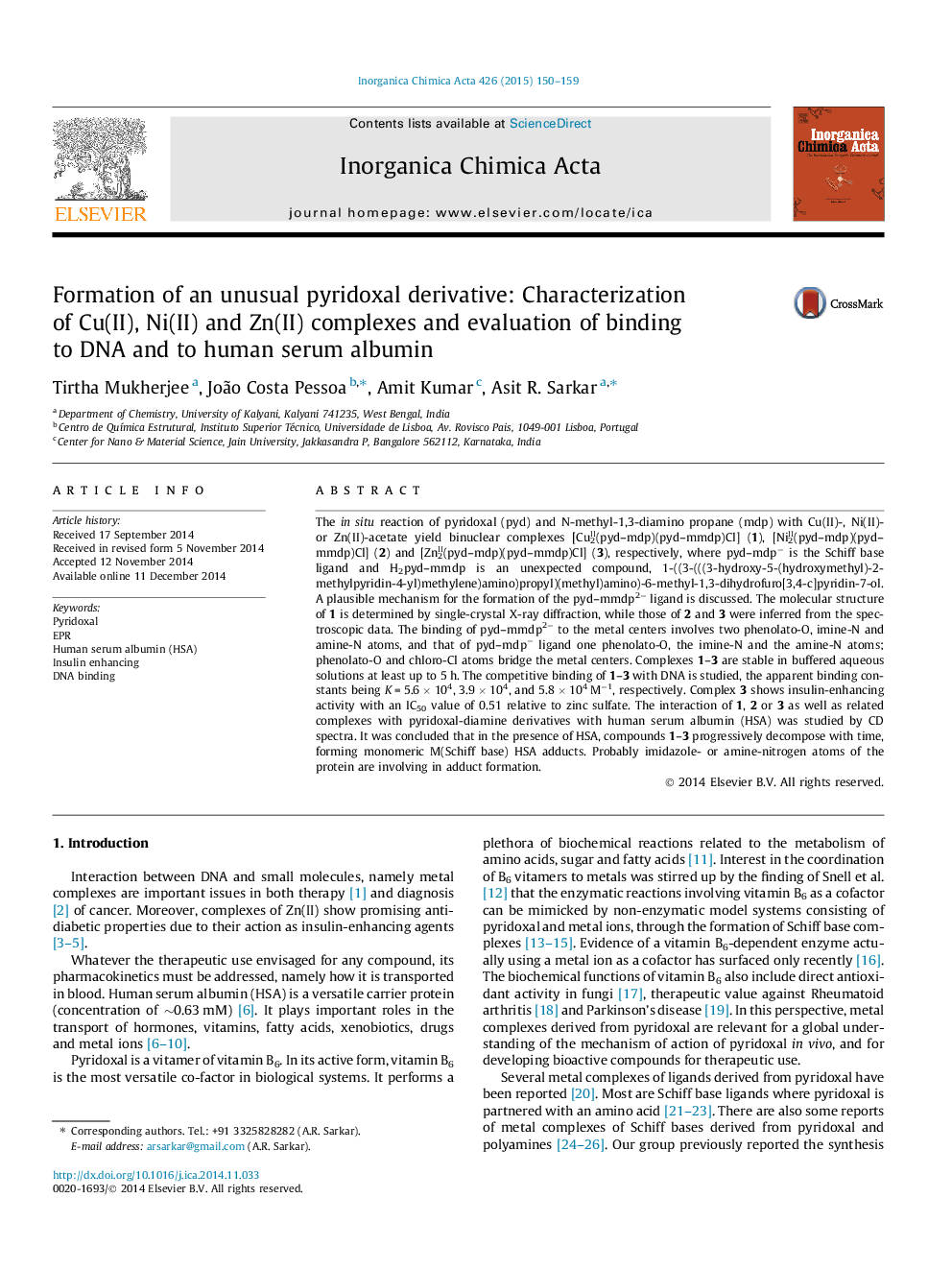| کد مقاله | کد نشریه | سال انتشار | مقاله انگلیسی | نسخه تمام متن |
|---|---|---|---|---|
| 1306741 | 1499163 | 2015 | 10 صفحه PDF | دانلود رایگان |

• Unexpected 5′-OH condensed product from pyridoxal, N-methyl-1,3-diamino propane.
• Binuclear complexes of both expected and unexpected Schiff bases of Cu, Ni, and Zn.
• The complexes are grove binder towards DNA.
• Progressive decomposition of the complexes on binding with human serum albumin.
• Zn(II) complex shows moderate insulin-enhancing activity.
The in situ reaction of pyridoxal (pyd) and N-methyl-1,3-diamino propane (mdp) with Cu(II)-, Ni(II)- or Zn(II)-acetate yield binuclear complexes [CuII2(pyd–mdp)(pyd–mmdp)Cl] (1), [NiII2(pyd–mdp)(pyd–mmdp)Cl] (2) and [ZnII2(pyd–mdp)(pyd–mmdp)Cl] (3), respectively, where pyd–mdp− is the Schiff base ligand and H2pyd–mmdp is an unexpected compound, 1-((3-(((3-hydroxy-5-(hydroxymethyl)-2-methylpyridin-4-yl)methylene)amino)propyl)(methyl)amino)-6-methyl-1,3-dihydrofuro[3,4-c]pyridin-7-ol. A plausible mechanism for the formation of the pyd–mmdp2− ligand is discussed. The molecular structure of 1 is determined by single-crystal X-ray diffraction, while those of 2 and 3 were inferred from the spectroscopic data. The binding of pyd–mmdp2− to the metal centers involves two phenolato-O, imine-N and amine-N atoms, and that of pyd–mdp− ligand one phenolato-O, the imine-N and the amine-N atoms; phenolato-O and chloro-Cl atoms bridge the metal centers. Complexes 1–3 are stable in buffered aqueous solutions at least up to 5 h. The competitive binding of 1–3 with DNA is studied, the apparent binding constants being K = 5.6 × 104, 3.9 × 104, and 5.8 × 104 M−1, respectively. Complex 3 shows insulin-enhancing activity with an IC50 value of 0.51 relative to zinc sulfate. The interaction of 1, 2 or 3 as well as related complexes with pyridoxal-diamine derivatives with human serum albumin (HSA) was studied by CD spectra. It was concluded that in the presence of HSA, compounds 1–3 progressively decompose with time, forming monomeric M(Schiff base) HSA adducts. Probably imidazole- or amine-nitrogen atoms of the protein are involving in adduct formation.
Pyridoxal (pyd) and N-methyl-1,3-diamino propane (mdp) with metal acetates, yield binuclear complexes [MII2(pyd–mdp)(pyd–mmdp)Cl] (M = Cu, Ni, Zn; pyd–mdp− = Schiff base ligand, unexpected compound, H2pyd–mmdp = 1-((3-(((3-hydroxy-5-(hydroxymethyl)-2-methylpyridin-4-yl)methylene)amino)propyl)(methyl)amino)-6-methyl-1,3-dihydrofuro[3,4-c]pyridin-7-ol. Characterised by crystallography, spectroscopic and theoretical methods. Classical groove binders to DNA. [ZnII2(pyd–mdp)(pyd–mmdp)Cl] comparable IC50 value with Zn(picolinato)2. Complexes form monomeric M(Schiff base)-HSA adduct in solution with HSA.Figure optionsDownload as PowerPoint slide
Journal: Inorganica Chimica Acta - Volume 426, 24 February 2015, Pages 150–159